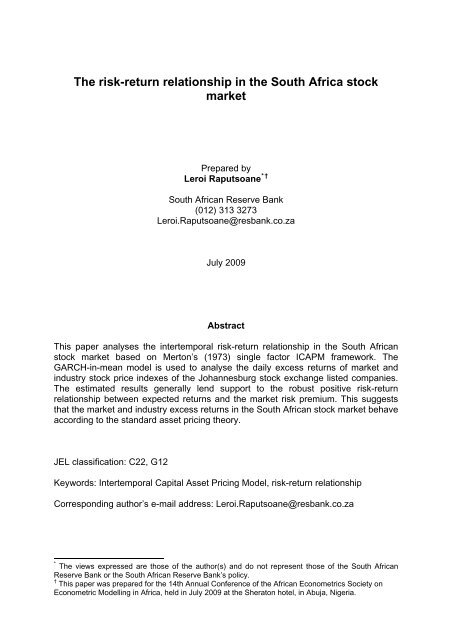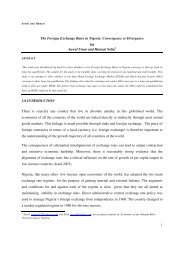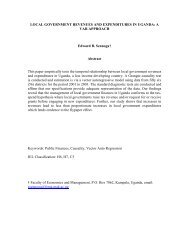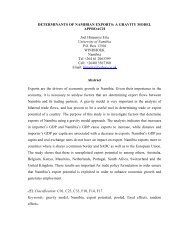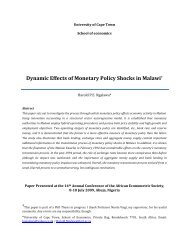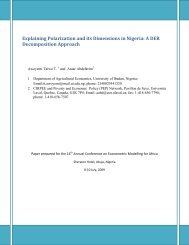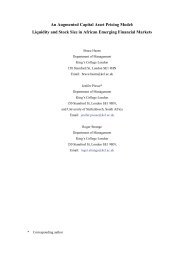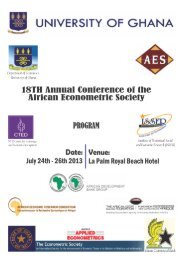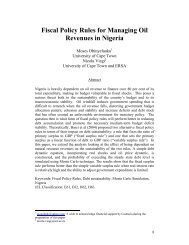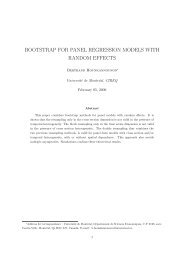The risk-return relationship in the South Africa stock market - African ...
The risk-return relationship in the South Africa stock market - African ...
The risk-return relationship in the South Africa stock market - African ...
You also want an ePaper? Increase the reach of your titles
YUMPU automatically turns print PDFs into web optimized ePapers that Google loves.
<strong>The</strong> <strong>risk</strong>-<strong>return</strong> <strong>relationship</strong> <strong>in</strong> <strong>the</strong> <strong>South</strong> <strong>Africa</strong> <strong>stock</strong><strong>market</strong>Prepared byLeroi Raputsoane * †<strong>South</strong> <strong>Africa</strong>n Reserve Bank(012) 313 3273Leroi.Raputsoane@resbank.co.zaJuly 2009AbstractThis paper analyses <strong>the</strong> <strong>in</strong>tertemporal <strong>risk</strong>-<strong>return</strong> <strong>relationship</strong> <strong>in</strong> <strong>the</strong> <strong>South</strong> <strong>Africa</strong>n<strong>stock</strong> <strong>market</strong> based on Merton’s (1973) s<strong>in</strong>gle factor ICAPM framework. <strong>The</strong>GARCH-<strong>in</strong>-mean model is used to analyse <strong>the</strong> daily excess <strong>return</strong>s of <strong>market</strong> and<strong>in</strong>dustry <strong>stock</strong> price <strong>in</strong>dexes of <strong>the</strong> Johannesburg <strong>stock</strong> exchange listed companies.<strong>The</strong> estimated results generally lend support to <strong>the</strong> robust positive <strong>risk</strong>-<strong>return</strong><strong>relationship</strong> between expected <strong>return</strong>s and <strong>the</strong> <strong>market</strong> <strong>risk</strong> premium. This suggeststhat <strong>the</strong> <strong>market</strong> and <strong>in</strong>dustry excess <strong>return</strong>s <strong>in</strong> <strong>the</strong> <strong>South</strong> <strong>Africa</strong>n <strong>stock</strong> <strong>market</strong> behaveaccord<strong>in</strong>g to <strong>the</strong> standard asset pric<strong>in</strong>g <strong>the</strong>ory.JEL classification: C22, G12Keywords: Intertemporal Capital Asset Pric<strong>in</strong>g Model, <strong>risk</strong>-<strong>return</strong> <strong>relationship</strong>Correspond<strong>in</strong>g author’s e-mail address: Leroi.Raputsoane@resbank.co.za* <strong>The</strong> views expressed are those of <strong>the</strong> author(s) and do not represent those of <strong>the</strong> <strong>South</strong> <strong>Africa</strong>nReserve Bank or <strong>the</strong> <strong>South</strong> <strong>Africa</strong>n Reserve Bank’s policy.† This paper was prepared for <strong>the</strong> 14th Annual Conference of <strong>the</strong> <strong>Africa</strong>n Econometrics Society onEconometric Modell<strong>in</strong>g <strong>in</strong> <strong>Africa</strong>, held <strong>in</strong> July 2009 at <strong>the</strong> Sheraton hotel, <strong>in</strong> Abuja, Nigeria.
Table of Contents1 Introduction ..............................................................................................................12 Literature review.......................................................................................................23 Methodology and data .............................................................................................43.1 Model............................................................................................................43.2 Data..............................................................................................................64 Empirical Results .....................................................................................................75 Conclusion................................................................................................................9References ............................................................................................................................11Appendix ...............................................................................................................................13List of TablesTable 1 Variables’ descriptive statistics ..............................................................................7Table 2 GARCH(1,1)-M model results................................................................................9Table A2 Variables’ descriptions.........................................................................................13ii
1 IntroductionStandard asset pric<strong>in</strong>g <strong>the</strong>ory postulates a direct <strong>relationship</strong> between expectedexcess <strong>stock</strong> <strong>return</strong>s and <strong>risk</strong>. This <strong>risk</strong>-<strong>return</strong> trade-off is a long stand<strong>in</strong>gphenomenon <strong>in</strong> <strong>in</strong>vestments analysis and is <strong>the</strong> foundation of f<strong>in</strong>ancial economics(Leon, Nave and Rubio, 2005). Authors such as Ghysels, Santa-Clara and Valkanov(2004) describe this relation as <strong>the</strong> “first fundamental law of f<strong>in</strong>ance.” <strong>The</strong> <strong>risk</strong>-<strong>return</strong>trade-off is expla<strong>in</strong>ed by <strong>the</strong> Capital Asset Pric<strong>in</strong>g Model (CAPM), which relates <strong>the</strong>required <strong>return</strong> on <strong>in</strong>vestment to <strong>the</strong> <strong>risk</strong> of undertak<strong>in</strong>g such an <strong>in</strong>vestment.Specifically, Merton’s (1973) Intertemporal Capital Asset Pric<strong>in</strong>g Model (ICAPM)hypo<strong>the</strong>sises a positive correlation between expected <strong>return</strong> on an <strong>in</strong>vestment and<strong>the</strong> associated <strong>risk</strong>.<strong>The</strong> rate of <strong>return</strong> on an <strong>in</strong>vestment is weighted by <strong>the</strong> perceived <strong>risk</strong> of undertak<strong>in</strong>gsuch an <strong>in</strong>vestment. This implies a direct <strong>relationship</strong> between <strong>market</strong> <strong>risk</strong> and <strong>return</strong>for <strong>the</strong> reason that <strong>risk</strong>-averse <strong>in</strong>vestors require additional compensation forassum<strong>in</strong>g extra <strong>risk</strong>. Markets which are perceived by <strong>in</strong>vestors to be high <strong>risk</strong> areassociated with higher <strong>return</strong>s <strong>in</strong> order to compensate <strong>the</strong> <strong>risk</strong> <strong>in</strong>volved <strong>in</strong> <strong>in</strong>vest<strong>in</strong>g <strong>in</strong>such <strong>market</strong>s. Conversely, lower <strong>risk</strong> <strong>market</strong>s are characterised by relatively lower<strong>return</strong>s. Thus it is unambiguous that <strong>the</strong> <strong>risk</strong>-<strong>return</strong> <strong>relationship</strong> is a fundamentalconcept <strong>in</strong> <strong>in</strong>vestment decision mak<strong>in</strong>g and that it is accepted as <strong>the</strong> cornerstone ofrational expectations asset pric<strong>in</strong>g models.This paper exam<strong>in</strong>es <strong>the</strong> <strong>in</strong>tertemporal <strong>risk</strong>-<strong>return</strong> <strong>relationship</strong> <strong>in</strong> <strong>the</strong> <strong>South</strong> <strong>Africa</strong>n<strong>stock</strong> <strong>market</strong> based on Merton’s (1973) s<strong>in</strong>gle factor ICAPM framework. Although it isa long stand<strong>in</strong>g phenomenon <strong>in</strong> <strong>in</strong>vestments analysis, <strong>the</strong> empirical evidence on <strong>the</strong><strong>risk</strong>-<strong>return</strong> trade-off is ambiguous with some empirical studies document<strong>in</strong>g a weakor negative <strong>relationship</strong> at best. Thus <strong>the</strong>re is an ongo<strong>in</strong>g uncerta<strong>in</strong>ty <strong>in</strong> <strong>the</strong> literatureconcern<strong>in</strong>g this phenomenon and <strong>the</strong> extent to which <strong>the</strong> expected <strong>return</strong> on<strong>in</strong>vestment is commensurate with <strong>the</strong> associated <strong>risk</strong> premium.<strong>The</strong> next section is <strong>the</strong> literature review which discusses <strong>the</strong> <strong>the</strong>oretical basis and <strong>the</strong>empirical f<strong>in</strong>d<strong>in</strong>gs on <strong>the</strong> <strong>risk</strong>-<strong>return</strong> <strong>relationship</strong>. <strong>The</strong> discussion on <strong>the</strong> empirical1
model and data is presented <strong>in</strong> section 3. Section 4 discusses <strong>the</strong> empirical results,while section 5 concludes.2 Literature reviewAssum<strong>in</strong>g rational, <strong>risk</strong>-averse <strong>in</strong>vestors, <strong>the</strong> Sharpe (1964) and L<strong>in</strong>tner (1965)Capital Asset Pric<strong>in</strong>g Model (CAPM) implies a positive, l<strong>in</strong>ear <strong>relationship</strong> between<strong>the</strong> expected <strong>market</strong> <strong>risk</strong> and <strong>return</strong>s. Merton (1973) estimated a variant of <strong>the</strong>traditional CAPM called <strong>the</strong> Intertemporal Capital Asset Pric<strong>in</strong>g Model (ICAPM).Similar to <strong>the</strong> CAPM, <strong>the</strong> ICAPM implies a positive, l<strong>in</strong>ear <strong>relationship</strong> between <strong>the</strong>aggregate <strong>market</strong> <strong>return</strong> and <strong>the</strong> <strong>market</strong> <strong>risk</strong> premium of <strong>the</strong> <strong>market</strong>. This assetpric<strong>in</strong>g model can be summarised by <strong>the</strong> follow<strong>in</strong>g equation:E JW ww2wftrm, t1 rf. t1 Etm,t1 Etmf , t1JwJw J [1] where E r r is <strong>the</strong> conditional <strong>market</strong> <strong>return</strong> between period t and t 1.t m, t1f , t1is <strong>the</strong> rate of <strong>return</strong> on <strong>the</strong> <strong>stock</strong> <strong>market</strong> <strong>in</strong>dex andE r t m, t1r f , t1is <strong>the</strong> rate of <strong>return</strong>on <strong>risk</strong>-free asset.E2t m , t 1is <strong>the</strong> conditional variance of <strong>the</strong> <strong>market</strong> <strong>return</strong> or <strong>the</strong> <strong>risk</strong>component.E is <strong>the</strong> covariance of <strong>the</strong> <strong>market</strong> <strong>return</strong> with <strong>in</strong>vestmenttmf , t1opportunities or <strong>the</strong> hedge component. W ( t 1)is wealth and F(t 1) is <strong>the</strong> vector ofstate variables that describe wealth such thatJ ( W ( t 1),F(t 1),t 1) is <strong>the</strong> <strong>in</strong>directutility function of wealth. JJwwwWis positive if <strong>in</strong>vestors are <strong>risk</strong> averse.is <strong>the</strong> measure of <strong>risk</strong> aversion or price of <strong>risk</strong> andAssum<strong>in</strong>g that <strong>in</strong>vestors have a recursive (power) utility function and <strong>the</strong> rates of<strong>return</strong> are <strong>in</strong>dependent and identically distributed, Merton (1980) agues that relative<strong>risk</strong> aversion is constant such that that <strong>the</strong> hedge component is negligible. Inparticular, Guo and Neely (2006) argue that <strong>in</strong>vestment opportunities are sluggish,such that <strong>the</strong>ir impact on <strong>stock</strong> <strong>return</strong>s is almost constant <strong>in</strong> <strong>the</strong> short term. Thismakes <strong>the</strong> case for <strong>the</strong> exclusion of <strong>the</strong> hedge component and <strong>the</strong> use of high2
frequency data to precisely uncover <strong>the</strong> <strong>risk</strong>-<strong>return</strong> <strong>relationship</strong>. <strong>The</strong>refore, it followsthat: JwwW2Etrm , t1 rf. t1 Et m,t1[2] Jw so that <strong>the</strong> ICAPM is a s<strong>in</strong>gle factor model where <strong>the</strong> conditional excess <strong>market</strong><strong>return</strong> is directly related to <strong>the</strong> conditional variance of <strong>the</strong> <strong>market</strong>. Equation [2] can bewritten as:E r r 2t m, t1f . t10 m m,t1[3]where, as discussed above, mis positive given <strong>in</strong>vestor <strong>risk</strong> aversion and 0isequal to zero.S<strong>in</strong>ce Merton’s (1973) work, <strong>the</strong> s<strong>in</strong>gle factor <strong>risk</strong>-<strong>return</strong> <strong>relationship</strong> has beensubject to volum<strong>in</strong>ous empirical <strong>in</strong>vestigation, with empirical studies found<strong>in</strong>gconflict<strong>in</strong>g results on <strong>the</strong> sign and statistical significance of <strong>the</strong> coefficient of <strong>risk</strong>aversion (Guo and Whitelaw, 2001). <strong>The</strong> <strong>relationship</strong> between <strong>market</strong> <strong>risk</strong>-<strong>return</strong> isfound to be positive and statistically significant by Bollerslev, Engle and Wooldridge(1988), Chou (1988) as well as Harvey (1989). Campbell (1987), Turner, Startz andNelson (1989) as well as Glosten, Jaganathan and Runkle (1993) document anegative and statistically significant <strong>relationship</strong>, while French, Schwert andStambaugh (1987) as well as Baillie and DeGenmaro (1990) f<strong>in</strong>d no statisticallysignificant <strong>risk</strong>-<strong>return</strong> trade-off. None<strong>the</strong>less, a positive, statistically significant <strong>risk</strong><strong>return</strong><strong>relationship</strong> has been re<strong>in</strong>stated by Scruggs (1998) and more recent studiessuch as Guo and Whitelaw (2001), Ghysels, Santa-Clara and Valkanov (2004) aswell as Leon, Nave and Rubio, (2005).It is apparent form <strong>the</strong> forego<strong>in</strong>g discussion that <strong>the</strong> empirical applications of <strong>the</strong>Merton’s s<strong>in</strong>gle factor <strong>risk</strong>-<strong>return</strong> have achieved mixed successes. <strong>The</strong> majority of <strong>the</strong>studies use several variants of <strong>the</strong> General Autoregressive ConditionalHeteroscedasticity (GARCH) model to estimate <strong>the</strong> <strong>risk</strong>-<strong>return</strong> <strong>relationship</strong>. <strong>The</strong>re are3
also <strong>in</strong>stances where Generalised Method of Moments (GMM) is used such as <strong>in</strong>Guo and Whitelaw (2001). Ghysels, Santa-Clara and Valkanov (2004) <strong>in</strong>troduce <strong>the</strong>Mixed Data Sampl<strong>in</strong>g (MIDAS) approach, which forecasts monthly variance with pastdaily squared <strong>return</strong>s. Although most studies use monthly data, <strong>the</strong> use of dailydenom<strong>in</strong>ated data is also prevalent. Intraday and quarterly data features <strong>in</strong> somestudies such as Balios (2008) and Guo (2002), respectively. Data span variesconsiderably with Ghysels, Santa-Clara and Valkanov (2004) as well as Lundblad(2004) employ<strong>in</strong>g <strong>the</strong> longest, which cover 76 and 68 years, respectively.3 Methodology and data3.1 ModelFollow<strong>in</strong>g Merton’s (1973) s<strong>in</strong>gle factor <strong>risk</strong>-<strong>return</strong> framework, <strong>the</strong> follow<strong>in</strong>g estimableversion of equation [3] is estimated to establish <strong>the</strong> <strong>relationship</strong> between <strong>market</strong> <strong>risk</strong>premium and <strong>stock</strong> <strong>return</strong>s:2rm, trf , t 0 mm,t m,t [4]where r is <strong>the</strong> <strong>market</strong> <strong>return</strong> and r is <strong>the</strong> <strong>risk</strong>-free rate of <strong>return</strong> so that r r ism<strong>the</strong> excess <strong>market</strong> <strong>return</strong>.2mfis <strong>the</strong> variance of excess <strong>market</strong> <strong>return</strong>. mis <strong>the</strong> whitenoise error term, 0is <strong>the</strong> <strong>in</strong>tercept term and mapproximates <strong>the</strong> coefficient of<strong>market</strong> <strong>risk</strong> aversion. As implied by <strong>the</strong> <strong>the</strong>oretical model, <strong>the</strong> <strong>in</strong>tercept is restricted tozero and <strong>the</strong> coefficient of <strong>market</strong> <strong>risk</strong> aversion is positive. Accord<strong>in</strong>g to Merton(1980), <strong>the</strong> s<strong>in</strong>gle factor <strong>risk</strong>-<strong>return</strong> model can reasonably approximate <strong>the</strong> trade-offbetween time-vary<strong>in</strong>g <strong>risk</strong> premium and <strong>stock</strong> <strong>return</strong>s and has become <strong>the</strong> standardmodel <strong>in</strong> empirical f<strong>in</strong>ance literature.mfEquation [4] is estimated directly us<strong>in</strong>g <strong>the</strong> General Autoregressive ConditionalHeteroscedasticity <strong>in</strong> mean (GARCH-M) model by Engle, Lilien and Rob<strong>in</strong>s (1987).This model has received considerable popularity <strong>in</strong> <strong>the</strong> <strong>risk</strong>-<strong>return</strong> trade-off empiricalliterature because <strong>the</strong> GARCH type conditional variance is handy as a representation4
of <strong>the</strong> time-vary<strong>in</strong>g <strong>risk</strong> premium <strong>in</strong> excess <strong>return</strong>s. It is also desirable <strong>in</strong> that itspecifies <strong>the</strong> heteroskedastic conditional variance term directly <strong>in</strong>to <strong>the</strong> meanequation so that it characterises <strong>the</strong> evolution of <strong>the</strong> excess <strong>return</strong>s and conditionalvariance simultaneously.<strong>The</strong> GARCH(p, q )-M model is specified as follows: [4]2rm, trf, t0mm,tm,tqp222m, t jm,tj im,t1j1i1 [5]2m, tm,t1~ N(0,m,t)[6]where equation [4] and [5] are <strong>the</strong> mean and variance equations, respectively. is<strong>the</strong> constant,iand jare <strong>the</strong> coefficients of <strong>the</strong> ARCH and GARCH terms,respectively. <strong>The</strong> <strong>market</strong> conditional variancevariance based on past <strong>in</strong>formationm.2 mis a one step ahead forecast<strong>The</strong> assumption about <strong>the</strong> distribution of <strong>the</strong> error term is required because GARCHmodels are computed us<strong>in</strong>g <strong>the</strong> method of maximum likelihood. Gaussian (normal),student’s t and <strong>the</strong> general error distributions are <strong>the</strong> three commonly employedassumptions about <strong>the</strong> distribution of <strong>the</strong> error term. In this study, <strong>the</strong> residuals areassumed to be normally distributed as shown <strong>in</strong> equation [6] above. To ensure that<strong>the</strong> normality condition holds, <strong>the</strong> Bollerslev and Wooldridge (1992) quasi-maximumlikelihood standard errors are used. <strong>The</strong> vector of population parameters to beestimated is:2 ( ,,, , , )[7]In estimat<strong>in</strong>g <strong>the</strong> population parameters , <strong>the</strong> follow<strong>in</strong>g conditional log likelihoodfunction is maximised under <strong>the</strong> assumption of normally distributed errors:5
TT21 2 L( ) L t( ) log( ) log(2) [8]2t1 t12 where <strong>the</strong> first two conditional moments should be correctly specified to ensure that<strong>the</strong> parameters estimation is consistent.3.2 DataAnderson and Bollerslev (1997) argue that <strong>the</strong> use of high frequency data isdesirable to uncover <strong>the</strong> <strong>risk</strong>-<strong>return</strong> <strong>relationship</strong>. This is because it allows for a bettermeasurement of <strong>risk</strong> and enables precise identification of <strong>the</strong> <strong>risk</strong>-<strong>return</strong> trade-off.This is because high frequency data produces better estimates of conditionalvolatility process. <strong>The</strong> <strong>risk</strong>-<strong>return</strong> trade-off is estimated us<strong>in</strong>g daily <strong>return</strong>s on 50<strong>market</strong> and <strong>in</strong>dustry <strong>stock</strong> price <strong>in</strong>dexes of <strong>the</strong> Johannesburg <strong>stock</strong> exchange listedcompanies. <strong>The</strong>se <strong>market</strong> and <strong>in</strong>dustry <strong>stock</strong> price <strong>in</strong>dexes are weighted by <strong>market</strong>capitalisation, where <strong>in</strong>dustry <strong>stock</strong> price <strong>in</strong>dexes assume <strong>the</strong> Industry ClassificationBenchmark (ICB) system.<strong>The</strong> bond exchange yields on R153 (short term government bond) and R186 (longterm government bond) are used to approximate <strong>the</strong> <strong>risk</strong>-free rate of <strong>in</strong>terest. Moststudies use <strong>the</strong> three month treasury bill rate for this purpose. However, <strong>the</strong> <strong>risk</strong> freerate of <strong>return</strong> is only available <strong>in</strong> monthly frequency. All data are sourced from <strong>the</strong><strong>South</strong> <strong>Africa</strong>n Reserve Bank database and spans <strong>the</strong> period January 04, 1995 toFebruary 06, 2009. This yields 2635 data po<strong>in</strong>ts.<strong>The</strong> data for <strong>the</strong> <strong>in</strong>dustry <strong>stock</strong> price <strong>in</strong>dexes of aerospace and defence, personalcare and household products, tobacco, utilities, electricity, gas distribution, gas,water, and multiutilities as well as alternative exchange were not available and assuch, <strong>the</strong>ir <strong>risk</strong>-<strong>return</strong> <strong>relationship</strong>s could not be estimated. <strong>The</strong> <strong>market</strong> and <strong>in</strong>dustrialgroups’ <strong>stock</strong> <strong>in</strong>dexes descriptions are detailed <strong>in</strong> table A1 <strong>in</strong> <strong>the</strong> appendix and <strong>the</strong>irdescriptive statistics are shown on <strong>in</strong> table 1 below. Accord<strong>in</strong>g to <strong>the</strong> descriptivestatistics, consumer goods, food producers, equity <strong>in</strong>vestments as well asdevelopment and venture capital <strong>stock</strong> price <strong>in</strong>dexes show high volatility dur<strong>in</strong>g <strong>the</strong>sample period based on standard deviations.6
Table 1Variables’ descriptive statisticsVariable Std. Dev. Skewness Kurtosis Variable Std. Dev. Skewness KurtosisS01 1.578 -0.010 7.813 S30 2.209 1.197 17.897S02 2.095 0.308 8.466 S32 1.507 -0.357 7.156S03 2.168 0.323 8.269 S33 1.661 -0.417 6.970S04 2.758 0.611 7.921 S34 1.665 0.106 8.410S06 3.072 -13.76 444.1 S35 2.300 -0.116 6.368S07 2.543 -0.150 6.062 S36 1.798 -0.104 6.735S08 2.805 0.697 8.188 S37 2.538 -22.68 885.7S09 2.688 -0.231 10.20 S38 2.483 0.407 7.804S10 2.470 0.259 6.219 S39 1.821 -0.237 6.726S11 1.477 -0.168 7.420 S40 2.575 0.406 8.301S12 2.046 0.291 9.355 S45 1.636 0.019 7.240S13 1.403 0.148 6.314 S46 2.071 0.201 6.141S14 2.608 -21.81 843.7 S47 1.695 0.032 7.437S15 2.493 0.231 6.584 S48 1.907 -0.083 7.149S16 2.758 0.199 9.808 S49 17.81 49.67 2525.2S17 1.567 -0.248 7.343 S50 1.288 -0.130 7.892S19 1.707 -0.028 7.182 S51 1.872 -0.050 6.784S20 1.555 -0.188 6.933 S52 2.348 -0.280 9.304S21 1.684 -0.695 48.82 S53 1.836 0.082 5.335S22 17.84 49.54 2517.1 S54 2.439 -0.233 8.807S23 2.346 4.193 176.7 S55 22.34 40.08 1686.9S25 1.606 -0.145 6.384 S56 20.06 39.39 1647.9S26 1.935 0.026 6.410 S58 1.284 -0.466 9.781S27 17.70 49.95 2544.8 S59 1.104 -0.662 10.35S28 1.956 0.237 6.154 S62 1.677 0.050 7.5794 Empirical Results<strong>The</strong> maximum likelihood estimates of <strong>the</strong> ICAPM are estimated us<strong>in</strong>g <strong>the</strong>GARCH(1,1)-M model for <strong>the</strong> whole sample period. <strong>The</strong> data series for some of <strong>the</strong><strong>in</strong>dustry <strong>stock</strong> price <strong>in</strong>dexes do not span <strong>the</strong> sample period and as such, <strong>the</strong>ir <strong>risk</strong><strong>return</strong><strong>relationship</strong>s were estimated us<strong>in</strong>g data from January 04, 1999 up toDecember 30, 2005, April 03, 2007 and December 21, 2007 for m<strong>in</strong><strong>in</strong>g f<strong>in</strong>ance,technology and hardware as well as diamonds and gemstones <strong>in</strong>dustries,respectively, while <strong>the</strong> sample period for development capital and venture capitalspans January 02, 2002 to February 06, 2009.7
In accordance with ICAPM <strong>the</strong>ory, <strong>the</strong> <strong>in</strong>tercept term was restricted to zero <strong>in</strong> all <strong>the</strong>estimated GARCH-M models. Lanne and Saikkonen (2006) have also shown that <strong>the</strong><strong>in</strong>clusion of an <strong>in</strong>tercept term when it is statistically <strong>in</strong>significant results <strong>in</strong> lack ofpower <strong>in</strong> <strong>the</strong> standard Wald test on <strong>the</strong> mean effect parameter <strong>in</strong> <strong>the</strong> GARCH-Mmodel. Fur<strong>the</strong>rmore, <strong>the</strong> Bollerslev and Wooldridge (1992) quasi-maximum likelihoodstandard errors and <strong>the</strong> heteroscedastic consistent covariances are used to ensurethat <strong>the</strong> normality condition holds <strong>in</strong> all <strong>the</strong> estimated models.<strong>The</strong> maximum likelihood estimates of <strong>the</strong> GARCH-M model for <strong>the</strong> coefficient of <strong>risk</strong>aversion mare reported <strong>in</strong> table 2. Accord<strong>in</strong>g to <strong>the</strong> empirical results, out of <strong>the</strong> 50<strong>stock</strong> price <strong>in</strong>dexes, 45 (95 percent) show a positive and a highly statisticallysignificant coefficient of <strong>risk</strong> aversion. This <strong>in</strong>cludes <strong>the</strong> <strong>stock</strong> price <strong>in</strong>dexes for <strong>the</strong>overall <strong>market</strong> <strong>in</strong>dex and <strong>the</strong> <strong>in</strong>dexes of <strong>the</strong> major <strong>in</strong>dustries such as resources,Industrials, consumer goods, health care, telecommunications and f<strong>in</strong>ancials. This isalso <strong>the</strong> case with <strong>the</strong> major group <strong>in</strong>dexes such as <strong>the</strong> top 40, mid cap and smallcap <strong>stock</strong> <strong>in</strong>dexes.<strong>The</strong> <strong>stock</strong> price <strong>in</strong>dexes for technology sub-sectors; software and computer servicesas well as technology and hardware are borderl<strong>in</strong>e statistically significant. Only 5 (5percent) of <strong>the</strong> 50 <strong>stock</strong> price <strong>in</strong>dexes show no statistically significant coefficient of<strong>risk</strong> aversion. <strong>The</strong>se are <strong>the</strong> <strong>in</strong>dexes for diamonds and germstones, construction andmaterials as well as technology, while <strong>the</strong> <strong>in</strong>dexes for automobiles and parts as wellas <strong>in</strong>dustrial transportation are not only statistically <strong>in</strong>significant but also shownegative coefficient of <strong>risk</strong> aversion.In summary, <strong>the</strong> empirical evidence on <strong>risk</strong>-<strong>return</strong> <strong>relationship</strong> as conjectured by <strong>the</strong>ICAPM is ambiguous with some empirical studies document<strong>in</strong>g a weak or negative<strong>relationship</strong> at best. In spite of this, <strong>the</strong> estimated results generally lend support to<strong>the</strong> robust positive <strong>risk</strong>-<strong>return</strong> <strong>relationship</strong> between expected <strong>return</strong>s and <strong>the</strong> <strong>market</strong><strong>risk</strong> premium <strong>in</strong> <strong>the</strong> <strong>South</strong> <strong>Africa</strong>n <strong>stock</strong> <strong>market</strong>, notwithstand<strong>in</strong>g <strong>the</strong> few exceptions.Consequently, <strong>the</strong> <strong>South</strong> <strong>Africa</strong>n <strong>stock</strong> <strong>market</strong> <strong>in</strong>dexes conform to <strong>the</strong> Merton’s(1973) ICAPM <strong>the</strong>oretical hypo<strong>the</strong>sis so that <strong>the</strong> expected <strong>return</strong> on an <strong>in</strong>vestment <strong>in</strong><strong>the</strong> <strong>South</strong> <strong>Africa</strong>n <strong>stock</strong> <strong>market</strong> is commensurate with <strong>the</strong> <strong>market</strong> <strong>risk</strong> premium.8
Table 2GARCH(1,1)-M model resultsm Std. Error z-Stat. Variable m Std. Error z-Stat.VariableS01 0.062 0.013 4.905 S30 0.031 0.008 3.732S02 0.042 0.010 4.289 S32 0.054 0.012 4.630S03 0.039 0.009 4.129 S33 0.040 0.011 3.686S04 0.014 0.007 2.061 S34 0.042 0.012 3.623S06** 0.004 0.007 0.628 S35 0.025 0.008 3.079S07 0.026 0.008 3.405 S36 0.036 0.011 3.414S08 0.026 0.007 3.833 S37** -0.002 0.004 -0.404S09 0.016 0.007 2.294 S38 0.030 0.008 3.847S10 0.029 0.008 3.558 S39 0.040 0.010 3.851S11 0.064 0.013 5.077 S40 0.023 0.008 3.070S12 0.040 0.010 4.092 S45 0.042 0.011 3.797S13 0.062 0.013 4.604 S46 0.031 0.009 3.563S14** 0.004 0.003 1.285 S47 0.044 0.011 4.097S15 0.021 0.008 2.724 S48 0.025 0.010 2.489S16 0.021 0.007 3.062 S49 0.006 0.000 20.022S17 0.062 0.013 4.909 S50 0.059 0.015 3.970S19 0.056 0.011 5.189 S51 0.029 0.010 3.004S20 0.044 0.012 3.578 S52** 0.009 0.007 1.210S21 0.055 0.015 3.711 S53 0.021 0.011 1.970S22 0.006 0.000 18.335 S53 0.021 0.011 1.970S23** 0.000 0.010 -0.012 S55 0.005 0.000 16.591S25 0.046 0.012 3.945 S56 0.001 0.000 2.796S26 0.032 0.010 3.100 S58 0.076 0.013 5.770S27 0.006 0.000 93.128 S59 0.100 0.016 6.236S28 0.041 0.009 4.334 S62 0.057 0.012 4.765** Statistical <strong>in</strong>significance at 5 percent level5 ConclusionThis study exam<strong>in</strong>ed <strong>the</strong> <strong>in</strong>tertemporal <strong>risk</strong>-<strong>return</strong> <strong>relationship</strong> <strong>in</strong> <strong>the</strong> <strong>South</strong> <strong>Africa</strong>n<strong>stock</strong> <strong>market</strong> based on Merton’s (1973) s<strong>in</strong>gle factor ICAPM framework. <strong>The</strong>GARCM-M model by Engle, Lilien and Rob<strong>in</strong>s (1987) is used to estimate <strong>the</strong> <strong>risk</strong><strong>return</strong>trade-off of 50 daily excess <strong>return</strong>s of <strong>market</strong> and <strong>in</strong>dustry <strong>stock</strong> price <strong>in</strong>dexesof <strong>the</strong> Johannesburg <strong>stock</strong> exchange listed companies. Accord<strong>in</strong>g to <strong>the</strong> empiricalresults, 95 percent of <strong>stock</strong> price <strong>in</strong>dexes show a positive and a highly statisticallysignificant coefficient of <strong>risk</strong> aversion, while 5 percent are not only statistically9
<strong>in</strong>significant but also show negative coefficient of <strong>risk</strong> aversion. This suggests that,generally, <strong>the</strong> <strong>market</strong> and <strong>in</strong>dustry <strong>stock</strong> prices <strong>in</strong> <strong>the</strong> <strong>South</strong> <strong>Africa</strong>n <strong>stock</strong> <strong>market</strong>conform to <strong>the</strong> Merton’s (1973) ICAPM <strong>the</strong>oretical hypo<strong>the</strong>sis of a positive<strong>relationship</strong> between excess <strong>market</strong> <strong>return</strong>s and <strong>the</strong> <strong>market</strong> <strong>risk</strong> premium.Several challenges to successfully estimat<strong>in</strong>g <strong>the</strong> <strong>risk</strong>-<strong>return</strong> trade-off rema<strong>in</strong> andneed fur<strong>the</strong>r exam<strong>in</strong>ation. <strong>The</strong>se are <strong>the</strong> issues of <strong>the</strong> methodological approach,volatility characteristics of <strong>the</strong> <strong>risk</strong> premium as well as data span and frequency. Guoand Neely (2006) suggest that <strong>the</strong> leverage effects should be accounted for toaddress <strong>the</strong> asymmetry <strong>in</strong> <strong>the</strong> response to <strong>the</strong> conditional volatility. <strong>The</strong>y fur<strong>the</strong>rargue that <strong>the</strong> long run conditional variance is more important <strong>in</strong> <strong>the</strong> determ<strong>in</strong>ation ofequity <strong>risk</strong> premium, which calls for <strong>the</strong> component GARCH model to uncover <strong>the</strong>seshort and long run conditional variance dynamics. <strong>The</strong>re is also a need to explore<strong>the</strong> MIDAS approach by Ghysels, Santa-Clara and Valkanov (2004), which hasrecently become popular <strong>in</strong> uncover<strong>in</strong>g <strong>the</strong> <strong>market</strong> <strong>risk</strong>-<strong>return</strong> trade-off to see if it canreplicate <strong>the</strong> results <strong>in</strong> this paper.10
ReferencesAndersen, T. G. and Bollerslev, T., 1997. "Answer<strong>in</strong>g <strong>the</strong> Critics: Yes, ARCH ModelsDo Provide Good Volatility Forecasts," NBER Work<strong>in</strong>g Paper, No. 6023, NationalBureau of Economic ResearchBaillie, R. T. and DeGennaro R. P., 1990, Stock Returns and Volatility,” Journal ofF<strong>in</strong>ancial and Quantitative Analysis, Volume 25, Pages 203-214Balios, D., 2008, “Intraday Risk-<strong>return</strong> Relationship and price Patterns <strong>in</strong> <strong>the</strong> A<strong>the</strong>nsStock Exchange, Volume 3Bollerslev, T., Engle R. F., and Wooldridge, J. M., 1988, "A Capital Asset Pric<strong>in</strong>gModel with Time-Vary<strong>in</strong>g Covariances," Journal of Political Economy, volume 96,Issue 1, Pages 116-31, FebruaryBollerslev, T. and Wooldridge, J., 1992, "Quasi-maximum likelihood estimation and<strong>in</strong>ference <strong>in</strong> dynamic models with time-vary<strong>in</strong>g covariances," Econometric Reviews,vol. 11, No. 2, pp 143-172Campbell, J Y., 1987, “Stock Returns and <strong>the</strong> Term Structure,” Journal of F<strong>in</strong>ancialEconomics, Volume 18, pages 873-399Chou, R. Y., 1988, “Volatility Persistence and Stock Valuations: Some EmpiricalEvidence Us<strong>in</strong>g GARCH,” Journal of Econometrics, Volume 3, Pages 279-294Engle R. F., Lilien D. and Rob<strong>in</strong>s R., 1987, “Estimat<strong>in</strong>g Time Vary<strong>in</strong>g Risk Premia <strong>in</strong><strong>the</strong> Term Structure: <strong>The</strong> ARCH-M Model,” Econometrica, Vol. 55, pp 391-408French K. R., Schwert W. G. and Stambaugh R. F., 1987, “Expected Stock Returnsand Variance,” Journal of F<strong>in</strong>ancial Economics, Volume 19, Pages 3-29Ghysels, E., Santa-Clara, P. & Valkanov, R., 2004. "<strong>The</strong>re is a Risk-Return Trade-offAfter All," NBER Work<strong>in</strong>g Paper, No. 10913, National Bureau of Economic ResearchGlosten L. R., Jaganathan R. and Runkle D. E., 1987, “On <strong>the</strong> <strong>relationship</strong> Between<strong>the</strong> Expected Value and <strong>the</strong> Variance of <strong>the</strong> Nom<strong>in</strong>al Excess Return on Stocks,” Vol.48, Pages 1779-1801Guo H., 2002, “Understand<strong>in</strong>g <strong>the</strong> Risk-Return Trade-off <strong>in</strong> <strong>the</strong> Stock Market,”Work<strong>in</strong>g Paper, No 2001-001C, Federal Reserve Bank of St. LouisGuo H., and Whitelaw R. F., 2001, “Uncover<strong>in</strong>g <strong>the</strong> Risk-Return relation <strong>in</strong> <strong>the</strong> StockMarket,” Work<strong>in</strong>g Paper, No 2002-001A, Federal Reserve Bank of St. Louis11
Guo H., and Neely, C. J., 2006, "Investigat<strong>in</strong>g <strong>the</strong> <strong>in</strong>tertemporal <strong>risk</strong>-<strong>return</strong> relation <strong>in</strong><strong>in</strong>ternational <strong>stock</strong> <strong>market</strong>s with <strong>the</strong> component GARCH model," Work<strong>in</strong>g Papers,No. 6 Federal Reserve Bank of St. LouisHarvey C. R., 1989, “Time-Vary<strong>in</strong>g Conditional Covariances <strong>in</strong> Tests of Asset Pric<strong>in</strong>gModels,” Journal of F<strong>in</strong>ancial Economics, Volume 24, Pages 289-317Lanne, M. and Saikkonen, P., 2006, "Why is it so difficult to uncover <strong>the</strong> <strong>risk</strong>-<strong>return</strong>trade-off <strong>in</strong> <strong>stock</strong> <strong>return</strong>s?," Economics Letters, vol. 92, No. 1, pp 118-125, JulyLeon A., Nave J. and Rubio, G., 2005, "<strong>The</strong> Relationship between Risk andExpected Return <strong>in</strong> Europe," DFAEII Work<strong>in</strong>g Papers No. 200508, University of <strong>the</strong>Basque Country - Department of Foundations of Economic Analysis IIL<strong>in</strong>tner J., 1965, “Security Prices, Risk, and Maximal Ga<strong>in</strong>s from Diversification,”Journal of F<strong>in</strong>ance, Volume 23, Issue 2Lundblad C., 2007, "<strong>The</strong> <strong>risk</strong> <strong>return</strong> trade-off <strong>in</strong> <strong>the</strong> long run: 1836-2003," Journal ofF<strong>in</strong>ancial Economics, volume 85, Volume 1, pages 123-150, JulyMelton R., 1973, “An Intertemporal Capital Asset Pric<strong>in</strong>g Model,” Econometrica,Volume 41, Pages 867-887Melton R., 1980, “On Estimat<strong>in</strong>g <strong>the</strong> Expected Return on <strong>the</strong> Market: An ExploratoryInvestigation,” Journal of F<strong>in</strong>ancial Economics, Volume 8, pp 323-361Scruggs, J. T., 1998, "Resolv<strong>in</strong>g <strong>the</strong> Puzzl<strong>in</strong>g Intertemporal Relation between <strong>the</strong>Market Risk Premium and Conditional Market Variance: A Two-Factor Approach,"Journal of F<strong>in</strong>ance, Vol. 53, No.2, pp 575-603Sharpe W. F., 1964, “Capital Asset Prices: A <strong>The</strong>ory of Market Equilibrium underConditions of Risk,” Journal of F<strong>in</strong>ance, Volume 19, Issue 3Turner C. M., Startz R. and Nelson C. R., 1989, “ A Markov Model ofHeterockedasticity, Risk and Learn<strong>in</strong>g <strong>in</strong> <strong>the</strong> Stock Market,” Journal of F<strong>in</strong>ancialEconomics, Volume 25, Pages 3-2212
AppendixTable A2 Variables’ descriptionsShare/Bond Description Share/Bond Descriptionb40 R 153 Government bond s28Healthcare equipment andservicesb42 R 186 Government bond s30 Pharmaceutical and Biotechnologys01 All Share s32 Consumer servicess02 Resources s33 General retailerss03 M<strong>in</strong><strong>in</strong>g s34 Travel and leisures04 Gold m<strong>in</strong><strong>in</strong>g s35 Medias06 Diamonds & gemstones s36 Support servicess07 Plat<strong>in</strong>um & precious metals s37 Industrial transportations08 General m<strong>in</strong><strong>in</strong>g s38 Telecommunicationss09 M<strong>in</strong><strong>in</strong>g f<strong>in</strong>ance s39 Food and drug retailerss10 Oil & gas producers s40 Fixed l<strong>in</strong>e telecommunicationss11 SA all share <strong>in</strong>dustrials s45 F<strong>in</strong>ancialss12 Basic materials s46 Bankss13 Chemicals s47 Non-life <strong>in</strong>surances14 Construction & materials s48 Life <strong>in</strong>surances15 Forestry and paper s49 Equity <strong>in</strong>vestment <strong>in</strong>strumentss16 Industrial metals s50 Real estates17 Industrials s51 General f<strong>in</strong>ancials19 General <strong>in</strong>dustrials s52 Technologys20 Electronic and electrical equipment s53 Technology and hardwares21 Industrial eng<strong>in</strong>eer<strong>in</strong>g s54 Software and computer servicess22 Consumer goods s55 Development capitals23 Automobiles and parts s56 Venture capitals25 Health care s58 Mid Caps26 Beverages s59 Small Caps27 Food producers s62 Top 4013


